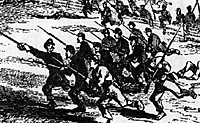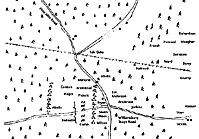The Battle of June 1, 1862
Background
 At the conclusion of the battle of May 31, the two armies lay exhausted on their arms with the new Confederate commander General G.W. Smith pondering the next move. The Union line had been driven back more than a mile east of Seven Pines, but it was being strengthened at all points. Richardson's, Kearny's, and Hooker's divisions were deployed along the railroad track leading to Fair Oaks in good positions. Smith decided, nevertheless, that he would launch an all-out attack. Longstreet, as always wary of frontal assaults, opposed the plan; whilst he was ordered to organize the attack, he became recalcitrant and merely instructed D.H. Hill to send a few brigades to probe the Federal positions.
At the conclusion of the battle of May 31, the two armies lay exhausted on their arms with the new Confederate commander General G.W. Smith pondering the next move. The Union line had been driven back more than a mile east of Seven Pines, but it was being strengthened at all points. Richardson's, Kearny's, and Hooker's divisions were deployed along the railroad track leading to Fair Oaks in good positions. Smith decided, nevertheless, that he would launch an all-out attack. Longstreet, as always wary of frontal assaults, opposed the plan; whilst he was ordered to organize the attack, he became recalcitrant and merely instructed D.H. Hill to send a few brigades to probe the Federal positions.
The Historical Battle
At 6:30 am, Hill sent two brigades, those of Wilcox and Pryor, along the Williamsburg Road to link up with Jenkins' and Anderson's brigades. He then ordered several brigades nominally part of Huger's Division in support to attack north of the railway line.
The advance towards the railway line was violently resisted by Richardson's Division which soon embarked on a counterattack led by the renowned Irish Brigade, under the command of Thomas Meagher. At the same time, Hooker counterattacked down the Williamsburg Road with two brigades and pushed the Rebels back. The battle was effectively over before 1:00 pm with neither side, in the end, having much to show for two days of hard fighting.
Smith was so traumatized by the burden of ultimate command that he had to be relieved a couple of days later by a general, whose influence on coming events would be momentous: Robert E. Lee.
The Scenario
This scenario is based upon the Rebel assaults and the strong Union counterattacks, east of Seven Pines on June 1. The game begins at 6:30 am with Confederate turn 1, and ends at 12:30 pm on Union turn 12.
On turn 1, Huger moves off towards the railway line and Anderson's Division moves down the Williamsburg Road; both have orders to engage the enemy. All brigades (except Jenkins' and Anderson's) are deployed in assault column as per the gaming map and are starting units. Jenkins' and Anderson's brigades are deployed in supporting line. There is no Confederate artillery present and all Union artillery starts limbered.
Scenario Rules
All woods are dense and affect movement, restrict visibility to 2", are -1 for cover, and are +1 for defending favorable ground.
The abatis acts as a ford and is +1 for defending favorable ground, but otherwise, it has no effect.
There are no corps commanders on the field. Anderson and Huger have commands composed of a mixture of brigades and are de facto commanders for gaming purposes.
Union Order of Battle
II Corps
Richardson's Division: Richardson, 1 leader
-
Howard's Brigade: 9/8/5
Meagher's Brigade: 9/7/5
French's Brigade: 10/8/6
2 Artillery
III Corps
Hooker's Division: Hooker, 1 leader
-
Sickle's Brigade: 9/8/5 (Elite)
Starr's Brigade: 9/8/5
Kearny's Division: Kearny, 1 (Elite) leader
-
Jameson's Brigade: 8/7/5
Ward's Brigade: 8/7/5
Berry's Brigade: 8/7/5
Confederate Order of Battle
Huger's Command: Huger, 1 leader
- Picketts' Brigade: 7/5/4 (Elite)
Armistead's Brigade: 7/5/4 (Elite)
Mahone's Brigade: 6/5/3 (Elite)
Colston's Brigade: 6/5/3
R.H. Anderson's Command: Anderson, 1 leader
- Wilcox's Brigade: 7/5/4
Pryor's Brigade: 7/5/4
Jenkins' Brigade: 6/5/3 (Elite)
Anderson's Brigade: 6/5/3

Bibliography
Echoes of Glory - Illustrated Atlas of the Civil War, Time Life Books
Forward to Richmond - Civil War Collectors Library, Time Life Books
The Peninsula Campaign, David G. Martin
Battles and Leaders of the Civil War (Johnson and Buell, editors)
Back to The Zouave Vol IX No. 1 Table of Contents
Back to The Zouave List of Issues
Back to Master Magazine List
© Copyright 1995 The American Civil War Society
This article appears in MagWeb (Magazine Web) on the Internet World Wide Web.
Other military history articles and gaming articles are available at http://www.magweb.com